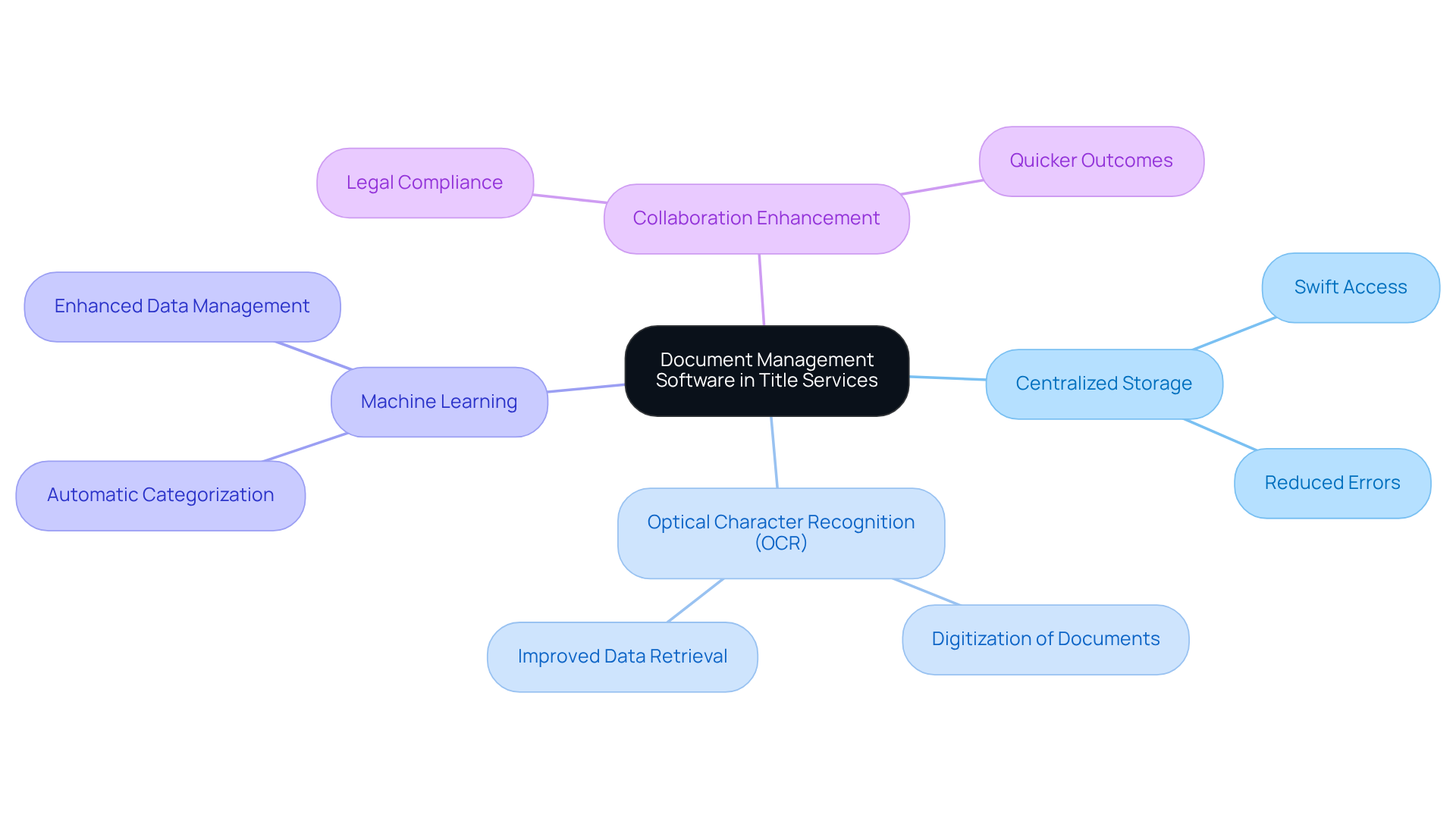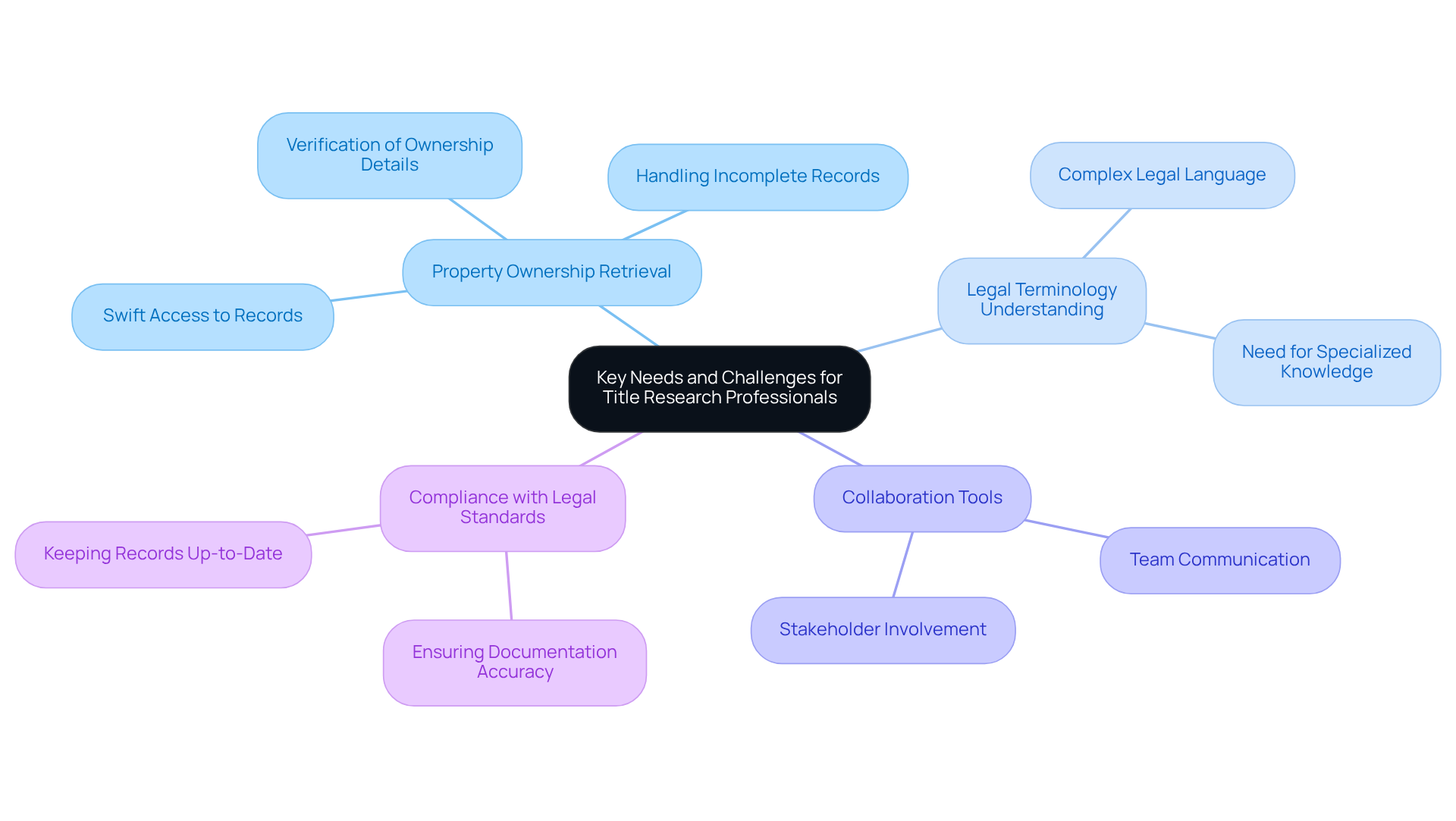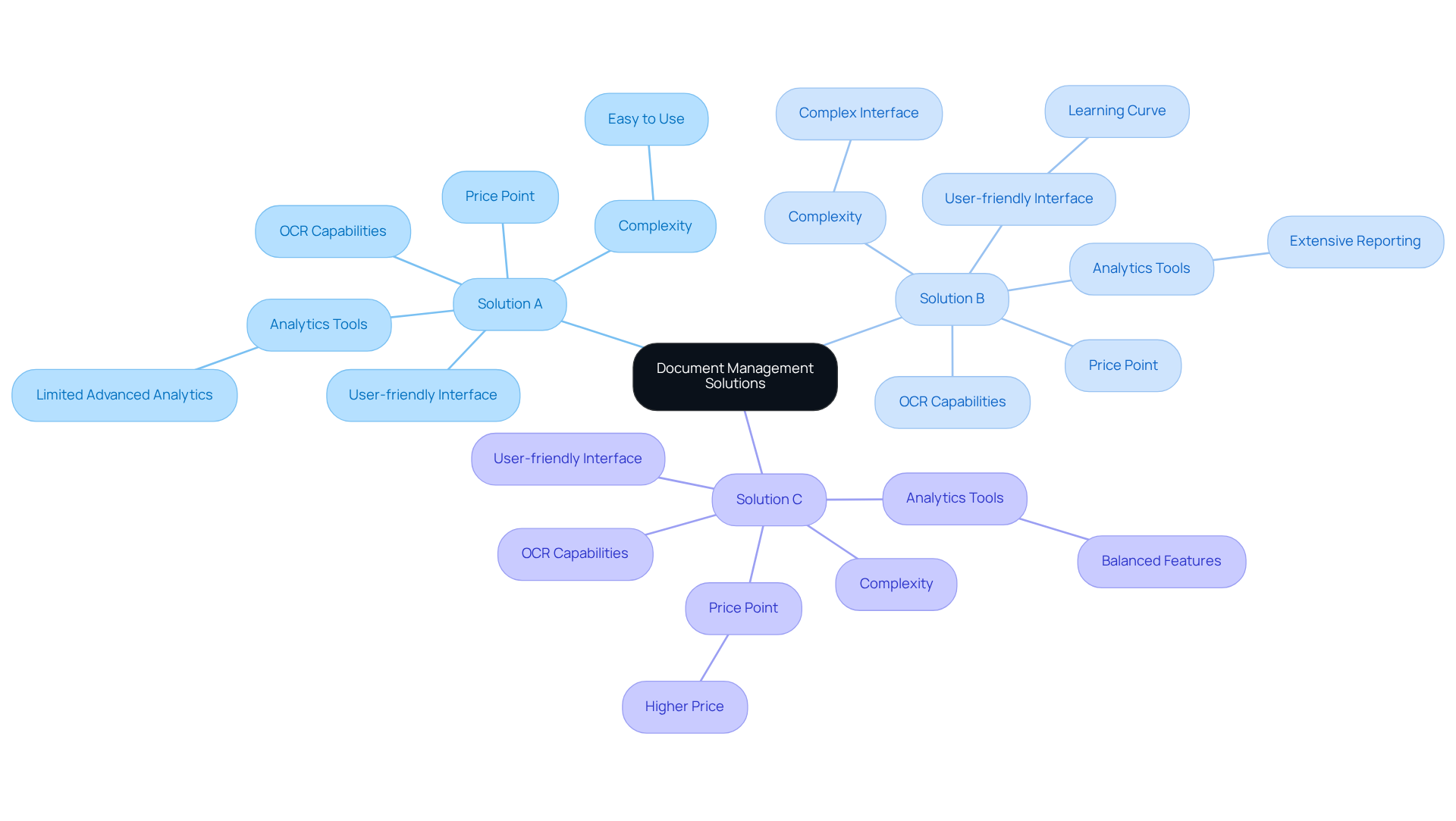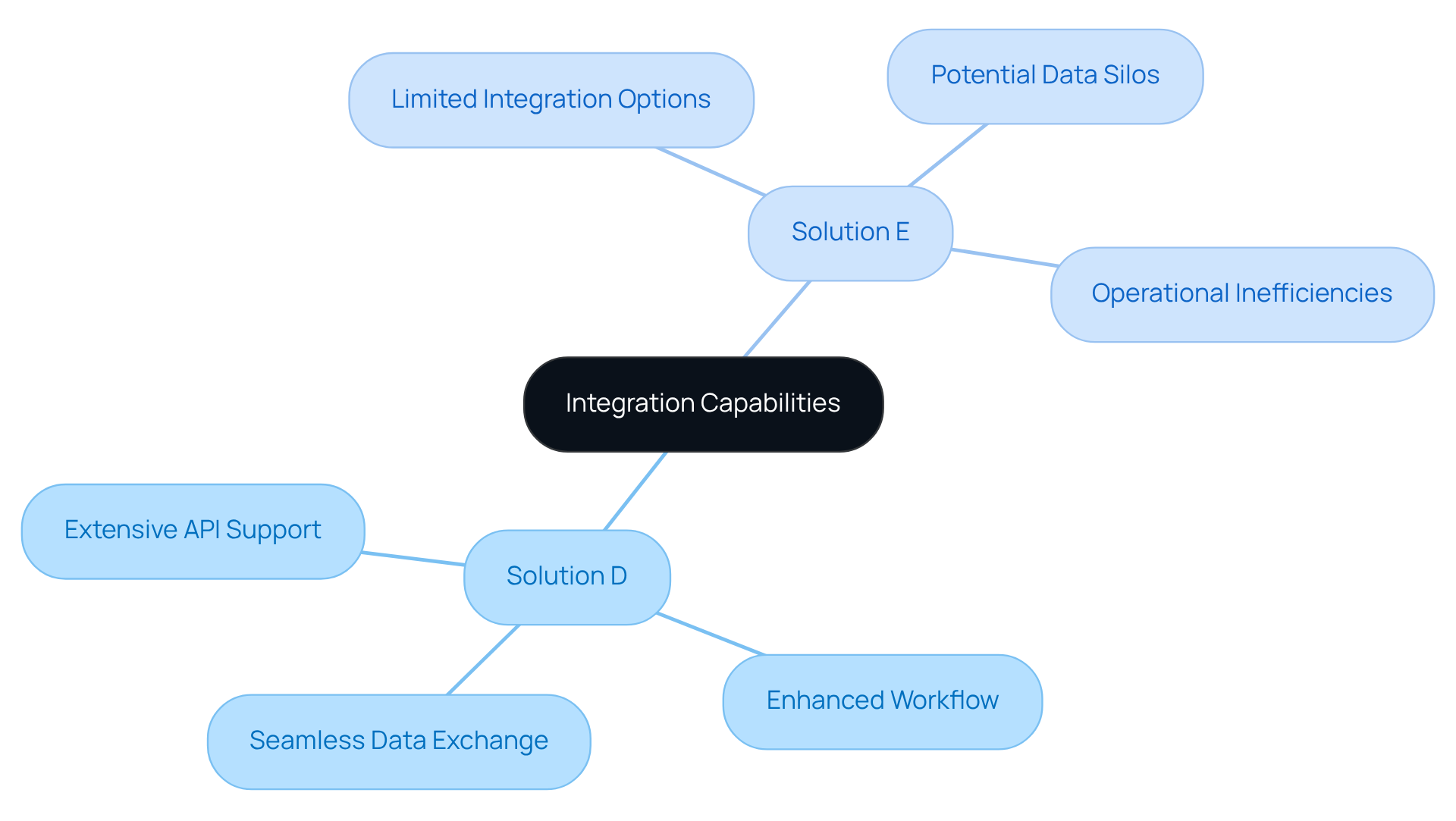Overview
This article presents a comprehensive comparison of document management software tailored for title services, meticulously analyzing various solutions and their distinctive features. The significance of accurate title research cannot be overstated, as it serves as the foundation for effective title services.
Furthermore, it underscores the critical capabilities of optical character recognition and seamless integration with existing systems. These features not only enhance operational efficiency but also foster improved collaboration among professionals in the field.
Consequently, they address the specific challenges encountered by title research experts, ultimately leading to a more streamlined workflow and greater productivity.
Introduction
Document management software has emerged as an indispensable asset in the title services industry, fundamentally transforming the storage, organization, and retrieval of ownership documents. By harnessing advanced capabilities such as optical character recognition and machine learning, these systems not only streamline workflows but also markedly diminish the risk of errors associated with manual processing.
Nevertheless, as title research professionals navigate a landscape replete with diverse software solutions, the pressing challenge persists: how can they discern the most suitable document management software that aligns with their specific requirements while ensuring compliance and fostering collaboration?
Understanding Document Management Software in Title Services
Document management software for title services is pivotal, providing a centralized platform for the storage, organization, and retrieval of ownership documents. Designed to manage substantial data volumes, these systems empower researchers to access essential information swiftly and effectively. Key features, such as optical character recognition (OCR), digitize paper documents, while machine learning algorithms automatically categorize and tag these documents. Consequently, this technology significantly diminishes the time spent on manual data entry and reduces errors associated with human oversight.
Furthermore, in document services, efficient document management software for title services not only assists professionals in meeting legal requirements but also enhances collaboration among team members. This collaboration ultimately leads to quicker and more accurate outcomes in property assessments, enabling firms to navigate the complexities of the real estate environment more effectively.

Key Needs and Challenges for Title Research Professionals
Title research professionals encounter numerous challenges that can impede their efficiency and accuracy. A primary requirement is the ability to swiftly retrieve and verify property ownership details from extensive records. Incomplete or inconsistent records can result in significant delays and potential legal complications.
Furthermore, the intricate nature of legal terminology in documents often necessitates specialized knowledge for accurate interpretation. Experts also need tools that foster collaboration among team members, as project analysis frequently involves various stakeholders.
Moreover, compliance with legal standards is essential, requiring systems that ensure all documentation is precise and up-to-date. Addressing these challenges is vital for enhancing the overall effectiveness of workflows utilizing document management software for title services.

Comparative Analysis of Leading Document Management Solutions
In the realm of record management applications for property services, several prominent solutions command attention.
- Solution A, for instance, boasts robust OCR capabilities alongside a user-friendly interface, rendering it ideal for teams that prioritize ease of use. However, it may fall short in offering advanced analytics features that some professionals deem necessary for comprehensive reporting.
- Conversely, Solution B excels in delivering extensive analytics and reporting tools, which can be invaluable for larger firms needing to monitor performance metrics. Yet, its complexity may present a learning curve for new users.
- Solution C effectively merges the strengths of both solutions, providing a balance of usability and advanced features, albeit at a higher price point.
Each solution presents its own set of advantages and disadvantages, and the ultimate selection hinges on the specific requirements of the project team, including budget constraints, team size, and the volume of materials managed.

Integration Capabilities with Existing Systems
Integration capabilities stand as a pivotal factor when selecting document management software for title services. Many professionals in this sector rely on a diverse array of tools, including customer relationship management (CRM) systems, accounting software, and various specialized applications. A document management system (DMS) that provides robust integration options can significantly streamline workflows by facilitating seamless data exchange between systems.
For example, Solution D boasts extensive API support, enabling users to effortlessly connect with their existing applications. In contrast, Solution E may present limited integration options, potentially resulting in data silos and operational inefficiencies.
Grasping the integration landscape is vital for title research teams, ensuring that their chosen document management software for title services enhances, rather than obstructs, their overall operational efficiency.

Conclusion
Document management software is essential for enhancing the efficiency and accuracy of title services, offering a centralized platform for managing ownership documents. By leveraging advanced technologies such as optical character recognition (OCR) and machine learning, these systems streamline workflows, reduce manual errors, and facilitate better collaboration among team members. This ultimately leads to improved outcomes in property assessments.
The article underscores several key aspects, including the specific needs and challenges faced by title research professionals. It emphasizes the critical nature of swift access to accurate records, adherence to legal standards, and the necessity for effective collaboration tools. Furthermore, a comparative analysis of leading document management solutions reveals a variety of options, each with distinct strengths and weaknesses, empowering teams to select the most suitable software based on their unique requirements.
In conclusion, the selection of the right document management software for title services transcends mere features; it involves identifying a solution that aligns with the operational needs and goals of the team. As the landscape of title research continues to evolve, embracing these technologies will be vital for professionals aiming to navigate complexities effectively and maintain a competitive edge. Investing in the right tools can significantly enhance productivity and accuracy, ultimately resulting in more successful title service operations.
Frequently Asked Questions
What is document management software in title services?
Document management software for title services is a centralized platform designed for the storage, organization, and retrieval of ownership documents.
What are the key features of document management software for title services?
Key features include optical character recognition (OCR) for digitizing paper documents and machine learning algorithms that automatically categorize and tag documents.
How does document management software improve efficiency?
It significantly reduces the time spent on manual data entry and minimizes errors associated with human oversight.
How does document management software assist with legal requirements?
The software helps professionals meet legal requirements by ensuring that documents are stored and organized correctly.
What impact does document management software have on team collaboration?
It enhances collaboration among team members, leading to quicker and more accurate outcomes in property assessments.
How does document management software help in navigating the real estate environment?
It enables firms to manage substantial data volumes efficiently, allowing them to navigate the complexities of the real estate environment more effectively.




